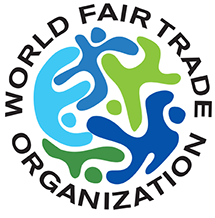World Fair Trade Organization

The World Fair Trade Organization (WFTO), formerly the International Federation of Alternative Traders ("IFAT"), was created in 1989 and is a global association of 324 organizations in over 70 countries.[1] Members are fair trade producer cooperatives and associations, export marketing companies, importers, retailers, national and regional fair trade networks and Fair Trade Support Organizations.
WFTO's mission is to improve the livelihoods and well being of disadvantaged producers by linking and promoting Fair Trade Organizations, and speaking out for greater justice in world trade.
WFTO's core fields of activities are:
- Developing the market for fair trade
- Building trust in fair trade
- Speaking out for fair trade
- Providing networking opportunities
- Empowering the regions
In 2004 WFTO launched a fair trade certification scheme and mark. The FTO Mark identifies registered Fair Trade Organizations worldwide (as opposed to products in the case of FLO International and Fairtrade mark) and guarantees that standards are being implemented regarding working conditions, wages, child labor and the environment. These standards are verified by self-assessment, mutual reviews and external verification. The FTO Mark is available to all WFTO members who meet the requirements of the WFTO Standards and Monitoring System and so far over 150 organizations have registered.
The WFTO operates in five key regions: Africa, Asia, Latin America, Europe and North America & Pacific Rim.[2]
Members in Africa, Asia, Europe and Latin America have come together to form WFTO regional chapters. They are:
- Cooperation for Fair Trade in Africa (COFTA)
- WFTO Asia
- WFTO Europe
- WFTO-LA – Associacion Latino Americana de Commercio Justo (WFTO Latin America)
WFTO logo
The WFTO logo is for organizations that demonstrate a 100% commitment to Fair Trade in all their business activities. Only monitored WFTO members are authorized to use the logo. Launched in 2004, the Fair Trade Organization Mark (WFTO Logo) shows that an organization follows the WFTO's 10 Principles of Fair Trade, covering working conditions, transparency, wages, the environment, gender equity and more.
The WFTO logo is not a product mark - it is used to brand organisations that are committed to 100% Fair Trade. It sets them apart from commercial as well as other Fair Trade businesses, and provides a clear signal to retailers, partners, governments and donors that their core activity is Fair Trade.
The WFTO is currently developing the WFTO Fair Trade System. The system was originally designed for marginalised producers currently not catered for by the Fairtrade Certification system, which was designed for commodity products. Due to the variety and complexity of handcrafts, for example, a product standard is technically difficult to apply. The system, then, provides an alternative that will verify that an organisation practices Fair Trade in all its activities. Once certified, the organisation will be able to use the label on all its products. [3]
10 principles of Fair Trade
WFTO prescribes 10 Principles that Fair Trade Organizations must follow in their day-to-day work and carries out monitoring to ensure these principles are upheld:
- Creating Opportunities for Economically Disadvantaged Producers
- Transparency and Accountability
- Fair Trading Practices
- Payment of a Fair Price
- Ensuring no Child Labor and Forced Labor
- Commitment to Non Discrimination, Gender Equity and Freedom of Association
- Ensuring Good Working Conditions
- Providing Capacity Building
- Promoting Fair Trade
- Respect for the Environment[4]
Regional Representative Bodies
Africa: COFTA
The Cooperation for Fair Trade in Africa - COFTA is the network of Fair Trade producer organisations operating in Africa and working with disadvantaged small-scale producers.[5]
Asia: WFTO-Asia
The Asian chapter of WFTO operates in 15 countries and comprises 90 fair trade organizations. Member nations represent mostly the poorest part of the continent: Bangladesh, China, Cambodia, India, Indonesia, Korea, Laos, Nepal, Pakistan, Philippines, Sri Lanka, Thailand, Timor Leste and Vietnam. Their roles in the fair trade operations vary, and included are: producers, cooperatives, retailers, NGO's, and faith-based organizations, amongst others.[6]
Europe: WFTO-EUROPE
WFTO-Europe, formerly known as IFAT Europe (International Federation for Alternative Trade), is formed by 84 members, amongst them Fair Trade organizations, Fair Trade networks and support organizations. It represents the European chapter of the World Fair Trade Organization.[7]
In 2009, the Network of European Worldshops (NEWS) was integrated into WFTO-Europe.[8]
Latin America: WFTO-LA
WFTO-LA is currently composed of 55 members from 13 countries of Latin America. The Regional Office is located in Areguá, Paraguay.[9]
The Pacific-Rim: WFTO-PACIFIC
WFTO-PacificRim is currently composed of 23 members from 5 countries around the Pacific - New Zealand, Australia, Japan, Canada, and USA. The Regional Office is located in Irvine, near Los Angeles, California, USA.
References
- ↑ "IFAT Annual Report 2007". IFAT. 2007. p. 33. Retrieved 27 January 2009.
- ↑ "Structure". WFTO. Retrieved 2012-10-19.
- ↑ "The WFTO Logo". Retrieved 4 June 2012.
- ↑ "10 Principle of Fair Trade". WFTO. Retrieved 5 June 2012.
- ↑ COFTA Website.
- ↑ WFTO Asia Website
- ↑ WFTO-Europe website
- ↑ "Annual Report 2009". World Fair Trade Organization. p. 10. Retrieved 23 May 2014.
- ↑ WFTO-LA Website
External links
- World Fair Trade Organization
- World Fair Trade Organization – Asian Chapter
- WFTO-LA – Associacion Latino Americana de Commercio Justo (WFTO Latin America)
- WFTO-Europe – World Fair Trade Organization-Europe (WFTO-Europe)
| ||||||||||||||||||||||||||||||||||